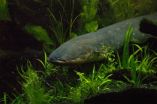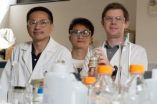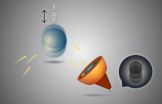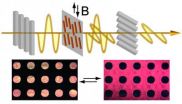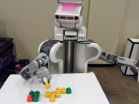(Press-News.org) LA JOLLA, CA – June 26, 2014 – Scientists working to make gene therapy a reality have solved a major hurdle: how to bypass a blood stem cell's natural defenses and efficiently insert disease-fighting genes into the cell's genome.
In a new study led by Associate Professor Bruce Torbett at The Scripps Research Institute (TSRI), a team of researchers report that the drug rapamycin, which is commonly used to slow cancer growth and prevent organ rejection, enables delivery of a therapeutic dose of genes to blood stem cells while preserving stem cell function.
These findings, published recently online ahead of print by the journal Blood, could lead to more effective and affordable long-term treatments for blood cell disorders in which mutations in the DNA cause abnormal cell functions, such as in leukemia and sickle cell anemia.
Improving Gene Delivery to Blood Stem Cells
Viruses infect the body by inserting their own genetic material into human cells. In gene therapy, however, scientists have developed "gutted" viruses, such as the human immunodeficiency virus (HIV), to produce what are called "viral vectors." Viral vectors carry therapeutic genes into cells without causing viral disease. Torbett and other scientists have shown that HIV vectors can deliver genes to blood stem cells.
For a disease such as leukemia or leukodystrophy, where mutations in the DNA cause abnormal cell function, efficiently targeting the stem cells that produce these blood cells could be a successful approach to halting the disease and prompting the body to produce healthy blood cells.
"If you produce a genetic modification in your blood stem cells when you are five years old, these changes are lifelong," said Torbett. Furthermore, the gene-modified stem cells can develop into many types of cells that travel throughout the body to provide therapeutic effects.
However, because cells have adapted defense mechanisms to overcome disease-causing viruses, engineered viral vectors can be prevented from efficiently delivering genes. Torbett said that when scientists extract blood stem cells from the body for gene therapy, HIV viral vectors are usually able to deliver genes to only 30 to 40 percent of them. For leukemia, leukodystrophy or genetic diseases where treatment requires a reasonable number of healthy cells coming from stem cells, this number may be too low for therapeutic purposes.
This limitation prompted Torbett and his team, including TSRI graduate student Cathy Wang, the first author of the study, to test whether rapamycin could improve delivery of a gene to blood stem cells. Rapamycin was selected for evaluation based on its ability to control virus entry and slow cell growth.
The researchers began by isolating stem cells from cord blood samples. They exposed the blood stem cells to rapamycin and HIV vectors engineered to deliver a gene for a green florescent protein, which causes cells to glow. This fluorescence provided a visual marker that helped the researchers track gene delivery.
The researchers saw a big difference in both mouse and human stem cells treated with rapamycin, where therapeutic genes were inserted into up to 80 percent of cells. This property had never been connected to rapamycin before.
Helping Blood Stem Cells Survive
The researchers also found that rapamycin can keep stem cells from differentiating as quickly when taken out of the body for gene therapy. This is important because scientists need time to work on extracted blood stem cells—yet once these cells leave the body, they begin to differentiate if manipulated into other types of blood cells and lose the ability to remain as stem cells and pass on therapeutic genes.
"We wanted to make sure the conditions we will use preserve stem cells, so if we transplant them back into our animal models, they act just like the original stem cells," said Torbett. "We showed that in two sets of animal models, stem cells remain and produce gene-modified cells."
The researchers hope these methods could someday be useful in the clinic. "Our methods could reduce costs and the amount of preparation that goes into modifying blood stem cells using viral vector gene therapy," said Wang. "It would make gene therapy accessible to a lot more patients."
She said the next steps are to carry out preclinical studies using rapamycin with stem cells in other animal models and then see if the method is safe and effective in humans. The team is also working to delineate the dual pathways of rapamycin's method of action in blood stem cells.
INFORMATION:
In addition to Wang and Torbett, other authors of the study "Rapamycin relieves lentiviral vector transduction resistance in human and mouse hematopoietic stem cells," include Blythe D. Sather, Xuefeng Wang, Iram Khan, Swati Singh, Gabrielle Curinga and Carol H. Miao of the Seattle Children's Research Institute; David J. Rawlings of the University of Washington School of Medicine and the Seattle Children's Research Institute; Jennifer Adair, Amie Adams and Hans-Peter Kiem of the Fred Hutchinson Cancer Research Center; and Shanshan Lang of TSRI. The study can be accessed at http://bloodjournal.hematologylibrary.org/content/early/2014/06/05/blood-2013-12-546218?sso-checked=1
The study was supported by the National Institutes of Health (grants P50GM103368, R01HL116221, R01HL091219, R01AI084457, R01AI071163, PL1-HL092557, RL1-HL092553, R21-HL112148, HL098489, HL084345 and AI097100), the Canadian CIHR Doctoral Research Award (grant 237503), the California HIV/AIDS Research Program (grant D12-SRI-355), the Center for AIDS Research (grant P30AI036214), the Seattle Children's Center for Immunity and Immunotherapies, the Markey Molecular Medicine Center at the University of Washington and the José Carreras/E. Donnall Thomas Endowed Chair for Cancer Research at Fred Hutchinson Cancer Research Center.
Scientists find potential new use for cancer drug in gene therapy for blood disorders
2014-06-26
ELSE PRESS RELEASES FROM THIS DATE:
Awareness month spurs web searches for autism
2014-06-26
PHILADELPHIA (June 26, 2014)—Autism Awareness Month each April brings blue lights and puzzle shapes out to shine in many communities – but does it actually lead to increased autism awareness? According to a new analysis of web search trends by researchers at Drexel University, it does appear to drive an increase in Google searches for autism – by a third over searches in March in recent years.
Brian K. Lee, PhD, an assistant professor in the Drexel University School of Public Health and research fellow of the A.J. Drexel Autism Institute, was senior author of the study ...
New infections cause dormant viruses to reactivate
2014-06-26
GAINESVILLE, Fla. — The famous slogan is "A diamond is forever," but that phrase might be better suited to herpes: Unlike most viruses, which succumb to the immune system's attack, herpes remains in the body forever, lying in wait, sometimes reactivating years later.
Researchers have long wondered what causes herpes viruses — two strains of which are linked to cancer — to reactivate after remaining dormant once the initial infection resolves. Now a team of researchers, including two University of Florida scientists, has discovered that interactions with other infections ...
Fighting parasitic infection inadvertently unleashes dormant virus
2014-06-26
Signals from the immune system that help repel a common parasite inadvertently can cause a dormant viral infection to become active again, a new study shows.
Further research is necessary to understand the clinical significance of the finding, but researchers at Washington University School of Medicine in St. Louis said the study helps illustrate how complex interactions between infectious agents and the immune system have the potential to affect illness.
The results appear online June 26 in Science Express.
The scientists identified specific signals in mice that ...
Sequencing electric eel genome unlocks shocking secrets
2014-06-26
EAST LANSING, Mich. — For the first time, the genome of the electric eel has been sequenced. This discovery has revealed the secret of how fishes with electric organs have evolved six times in the history of life to produce electricity outside of their bodies.
The research, published in the current issue of Science, sheds light on the genetic blueprint used to evolve these complex, novel organs. It was co-led by Michigan State University, University of Wisconsin-Madison, University of Texas-Austin and the Systemix Institute.
"It's truly exciting to find that complex ...
Water-cleanup catalysts tackle biomass upgrading
2014-06-26
Rice University chemical engineer Michael Wong has spent a decade amassing evidence that palladium-gold nanoparticles are excellent catalysts for cleaning polluted water, but even he was surprised at how well the particles converted biodiesel waste into valuable chemicals.
Through dozens of studies, Wong's team focused on using the tiny metallic specks to break down carcinogenic and toxic compounds. But his latest study, which is available online and due for publication in an upcoming issue of the Royal Society of Chemistry's journal Chemical Science, examined whether ...
Not much force: Berkeley researchers detect smallest force ever measured
2014-06-26
What is believed to be the smallest force ever measured has been detected by researchers with the Lawrence Berkeley National Laboratory (Berkeley Lab) and the University of California (UC) Berkeley. Using a combination of lasers and a unique optical trapping system that provides a cloud of ultracold atoms, the researchers detected a force of approximately 42 yoctonewtons. A yoctonewton is one septillionth of a newton and there are approximately 3 x 1023 yoctonewtons in one ounce of force.
"We applied an external force to the center-of-mass motion of an ultracold atom ...
Let there be light: Chemists develop magnetically responsive liquid crystals
2014-06-26
RIVERSIDE, Calif. — Chemists at the University of California, Riverside have constructed liquid crystals with optical properties that can be instantly and reversibly controlled by an external magnetic field. The research opens the door to display applications relying on the instantaneous and contactless nature of magnetic manipulation—such as signage, posters, writing tablets, and billboards.
Commercially available liquid crystals, used in modern electronic displays, are composed of rod-like or plate-like molecules. When an electric field is applied, the molecules rotate ...
Researchers conduct comprehensive review of treatments for depression in cancer patients
2014-06-26
Depression is common in cancer, up to half of all patients facing the disease experience depressive symptoms, ranging from mild to severe. When depression co-exists with cancer, patients may be at an increased risk of death from cancer and from suicide.
Antidepressants are commonly prescribed, but the evidence on their efficacy is mixed. The role of antidepressants in treating cancer-related depression has not been rigorously studied. To identify best practice for the treatment of depression in cancer, Dartmouth researchers completed a systematic review and meta-analysis ...
Ask the crowd: Robots learn faster, better with online helpers
2014-06-26
University of Washington computer scientists have shown that crowdsourcing can be a quick and effective way to teach a robot how to complete tasks. Instead of learning from just one human, robots could one day query the larger online community, asking for instructions or input on the best way to set the table or water the garden.
The research team presented its results at the 2014 Institute of Electrical and Electronics Engineers International Conference on Robotics and Automation in Hong Kong in early June.
"We're trying to create a method for a robot to seek help ...
New species of small mammal discovered by scientists from California Academy of Sciences
2014-06-26
SAN FRANCISCO (June 26, 2014) – Scientists from the California Academy of Sciences have discovered a new species of round-eared sengi, or elephant-shrew, in the remote deserts of southwestern Africa. This is the third new species of sengi to be discovered in the wild in the past decade. It is also the smallest known member of the 19 sengis in the order Macroscelidea. The team's discovery and description of the Etendeka round-eared sengi (Macroscelides micus) is published this week in the Journal of Mammalogy.
While collecting and examining sengi specimens from southwestern ...


